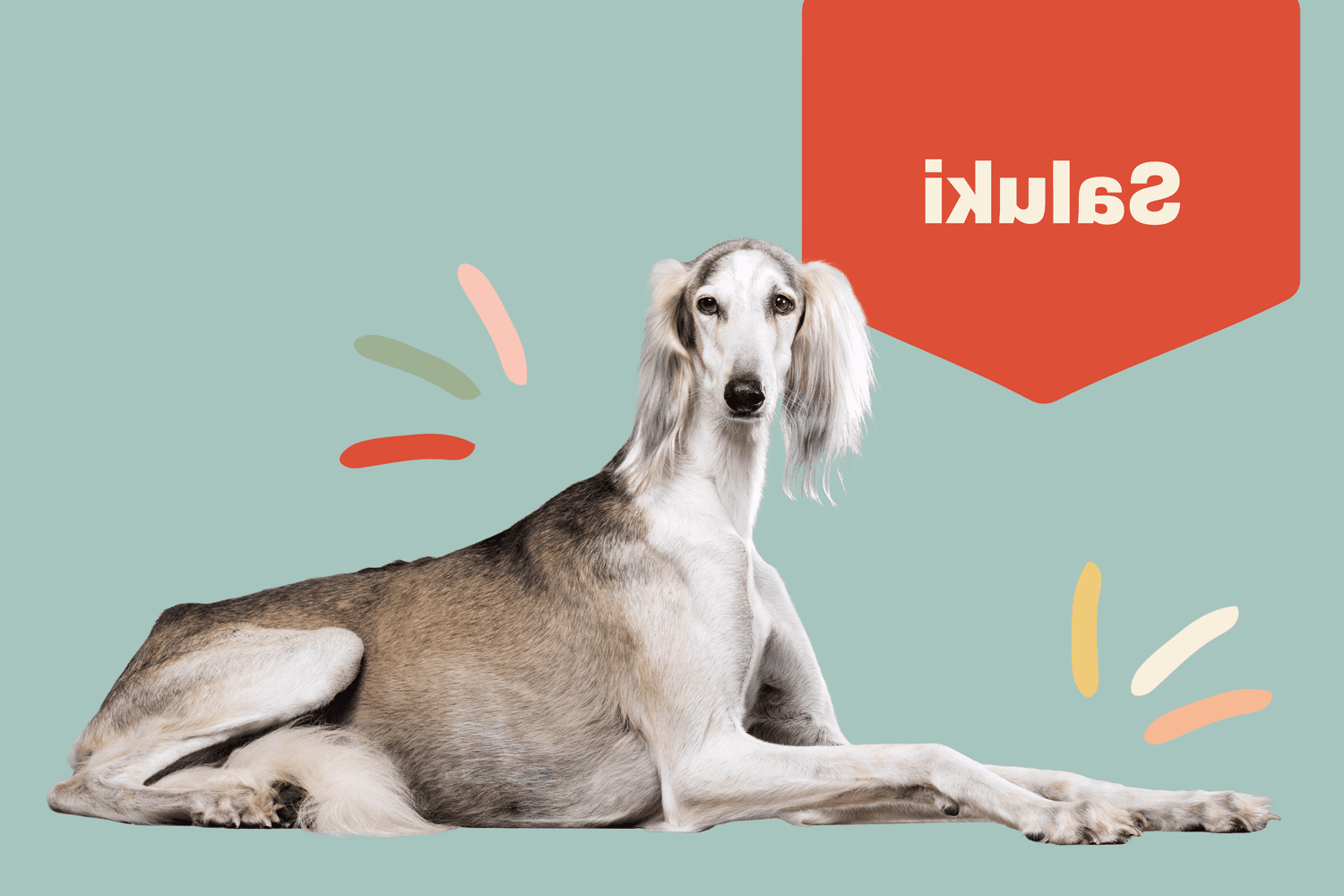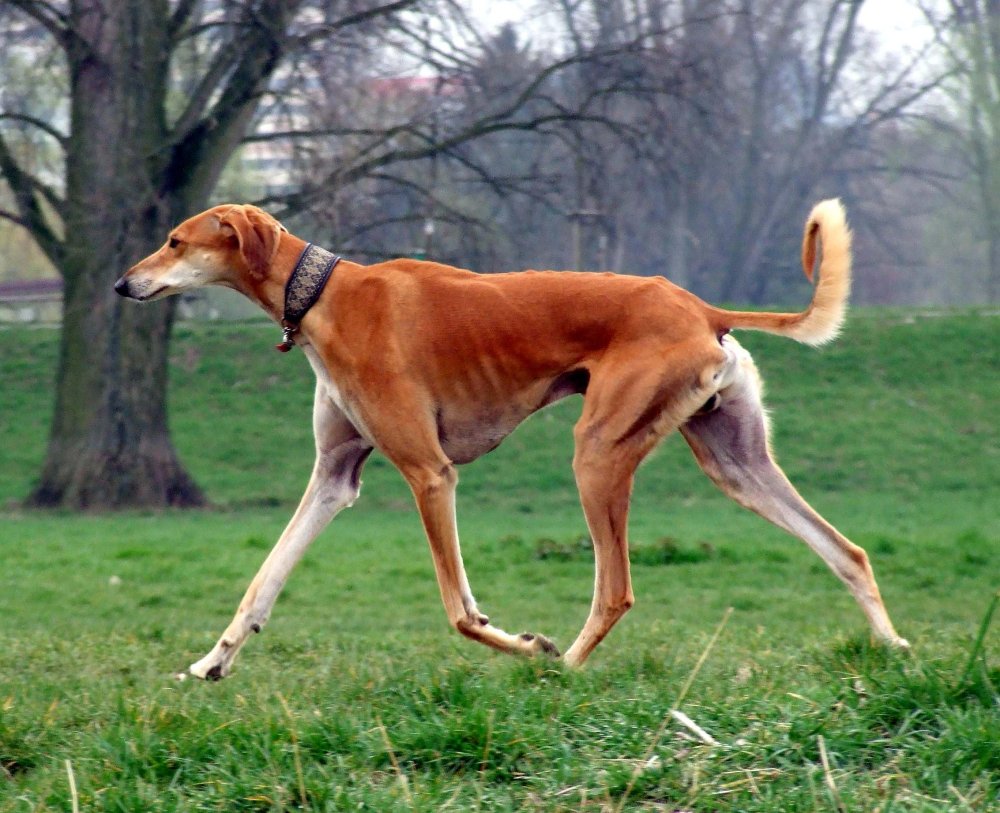- Breed Category: Hound
- Country of Origin: Middle East
- Average Height: Males 58-71 cm, Females 58-71 cm
- Average Weight: Males 20-30 kg, Females 16-25 kg
- Average Life Span: 12-14 years
- Grooming Requirements: Low, occasional brushing
- Exercise Requirements: High, needs daily exercise
- Coat Type: Smooth or feathered
- Coat Color Variations: Various, including white, cream, fawn
- Shedding Level: Low
- Ear Type: Long and hanging
- Tail Type: Long and curved
- Temperament: Gentle, reserved, independent
- Intelligence Level: High
- Barking Tendency: Low
- Compatibility with Children: Good with older children
- Compatibility with Other Pets: Generally good
- Training Ease: Moderate, requires patience
- Common Health Issues: Heart conditions, eye problems
- Dietary Needs: High-quality, balanced diet
- Energy Level: High
- Drooling Tendency: Low
- Sensitivity to Weather: Sensitive to cold
- Overall Maintenance Level: Moderate
- Original Purpose: Hunting and coursing
- Year of Recognition by Kennel Clubs: 1927
- Apartment Friendly: Yes, with sufficient exercise
- Best Suited For: Active families, experienced owners
- Cost of Ownership: Moderate to high
- Unique Traits: Graceful, fast runner
- Cultural Significance: Ancient breed, revered in Middle East
- Popularity Rank: Moderately popular
Imagine a dog that moves with the grace of a cheetah but has the elegance of a ballet dancer. That’s the Saluki for you. Known as one of the oldest dog breeds, the Saluki has a rich history that dates back to ancient Egypt. These dogs were once the companions of pharaohs, and their regal bearing is still evident today. With their slender bodies and long legs, Salukis are built for speed and endurance, making them exceptional hunters. But there’s more to them than just their athletic prowess. Salukis are known for their gentle and reserved nature, often forming deep bonds with their families. This article will delve into the unique characteristics, fascinating history, and essential care tips for this remarkable breed.
History and Origin of the Saluki

Ancient Origins of the Saluki
The Saluki is a breed with roots that stretch back thousands of years. Originating in the Middle East, these dogs were revered by ancient cultures, including the Egyptians, who often depicted them in their art. Their lineage is so ancient that they are considered one of the first domesticated dog breeds. This long history is a testament to their enduring appeal and adaptability.
Role in Hunting and Companionship
Salukis were not just admired for their beauty; they were also prized for their hunting skills. Their speed and agility made them perfect for chasing down game across the vast deserts. But beyond their hunting prowess, Salukis have always been cherished companions. Their gentle nature and loyalty have made them beloved members of families for centuries.
Cultural Significance in the Middle East
In the Middle East, the Saluki holds a special place in the hearts of many. Often referred to as the “Royal Dog of Egypt,” they are seen as symbols of grace and nobility. Their presence in the region’s history and culture is profound, reflecting a deep bond between humans and these elegant creatures.
Physical Characteristics of the Saluki

Appearance
Salukis are a sight to behold, with their sleek and slender bodies that seem to glide effortlessly. They typically stand between 58 to 71 centimetres tall and weigh around 18 to 27 kilograms. Their coat is short and smooth, often with feathering on the ears and tail, adding to their elegant appearance. Coat colours vary widely, including cream, fawn, red, black and tan, and even tricolour. Each Saluki is unique, with distinctive markings that can range from subtle to striking.
Unique Physical Traits
What truly sets the Saluki apart is their graceful build. Their long legs and narrow frame are designed for speed, allowing them to reach impressive velocities when in full stride. This breed’s deep chest and tucked-up abdomen contribute to their athletic prowess, making them one of the fastest dog breeds. Their large, expressive eyes and long, silky ears add to their regal look, capturing the essence of their ancient lineage.
Temperament and Behaviour of the Saluki

Typical Personality Traits
Salukis are known for their gentle and independent nature. They often exhibit a reserved demeanour, especially around strangers, but form deep, lasting bonds with their families. This breed is not overly demanding of attention, making them a good fit for those who appreciate a more laid-back companion. Despite their reserved nature, Salukis are affectionate and enjoy spending time with their loved ones.
Suitability as a Family Pet and Hunting Companion
As family pets, Salukis are well-suited to households that can provide them with the space and exercise they need. Their hunting instincts are still strong, so they thrive in environments where they can run and explore. While they may not be the best choice for first-time dog owners due to their independent streak, experienced owners will find them to be loyal and rewarding companions. Their history as hunting dogs means they can also excel in activities like lure coursing.
Interaction with Children and Other Animals
Salukis generally get along well with children, especially if they are raised together. They are gentle and patient, but it’s important to supervise interactions to ensure both the dog and child are comfortable. When it comes to other animals, Salukis can coexist peacefully, though their prey drive may be triggered by smaller pets. Early socialisation is key to fostering harmonious relationships with other animals in the household.
Training and Exercise Needs of the Saluki

Importance of Early Training and Socialisation
Getting a Saluki off to a good start with early training and socialisation is crucial. These dogs are naturally reserved, so exposing them to different environments, people, and other animals from a young age helps them grow into well-adjusted adults. This early exposure can prevent shyness and ensure they are comfortable in various situations.
Recommended Training Techniques
Salukis respond best to positive reinforcement techniques. They are intelligent but can be independent, so patience and consistency are key. Use treats, praise, and play to motivate them. Harsh methods won’t work with this sensitive breed and can damage the trust between you and your dog.
Daily Exercise Requirements and Activities They Enjoy
Salukis need plenty of exercise to keep them happy and healthy. A daily run or long walk is essential, and they love activities that let them stretch their legs, like lure coursing or agility. These activities not only satisfy their physical needs but also engage their minds, making them well-rounded companions.
Health and Lifespan of the Saluki

Common Health Issues
Salukis are generally healthy dogs, but like any breed, they can be prone to certain health issues. Some of the common concerns include heart conditions like cardiomyopathy, eye problems such as progressive retinal atrophy, and autoimmune disorders. Regular check-ups with a vet can help catch these issues early.
Average Lifespan and Health Tips
With proper care, Salukis typically live between 12 to 14 years. To keep them healthy, ensure they have a balanced diet, regular exercise, and mental stimulation. Their slender build means they need a comfortable place to rest, so a soft bed is a must. Regular grooming, especially of their ears and coat, helps maintain their elegant appearance.
Preventative Care Recommendations
- Schedule regular vet visits for health screenings and vaccinations.
- Maintain a consistent exercise routine to support their physical and mental well-being.
- Provide a high-quality diet tailored to their specific needs.
- Ensure dental hygiene with regular teeth brushing and dental check-ups.
- Monitor for any signs of health issues and address them promptly.
Grooming and Maintenance of the Saluki

Coat Care and Grooming Routines
Salukis have a short, smooth coat that requires minimal grooming, but regular care is still important to keep them looking their best. A weekly brush will help remove loose hairs and keep their coat shiny. Pay special attention to the feathering on their ears and tail, as these areas can tangle if neglected. A gentle brush or comb works well for this.
Shedding and Seasonal Grooming Tips
While Salukis are not heavy shedders, they do experience some seasonal shedding. During these times, you might need to increase brushing to a couple of times a week to manage the extra hair. This not only helps with shedding but also keeps their skin healthy by distributing natural oils. Bathing is only necessary when they get particularly dirty, as over-bathing can strip their coat of these oils.
Diet and Nutrition for the Saluki

Nutritional Needs for Optimal Health
Salukis, with their athletic build, require a diet rich in high-quality proteins and healthy fats to support their energy levels and muscle maintenance. A balanced diet with essential vitamins and minerals is crucial for their overall well-being. Omega-3 fatty acids are particularly beneficial for maintaining their sleek coat and supporting joint health.
Foods to Include and Avoid
Include lean meats like chicken, turkey, and fish, along with whole grains such as brown rice and oats. Vegetables like carrots and spinach can provide additional nutrients. Avoid foods high in fillers, artificial additives, and excessive fats, as these can lead to digestive issues and weight gain. Chocolate, grapes, and onions are toxic to dogs and should be strictly avoided.
Feeding Schedules and Portion Recommendations
Salukis do well with two meals a day, which helps maintain their energy levels and prevents bloating. Portion sizes should be adjusted based on their age, weight, and activity level. It’s important to monitor their weight and adjust portions accordingly to prevent obesity, which can strain their slender frame.
Fun Facts and Trivia about Salukis
Interesting Tidbits about the Breed
Salukis are often called the “Royal Dogs of Egypt,” a nod to their ancient lineage and esteemed status. They were so valued that they were often mummified alongside pharaohs. These dogs are not just fast; they can reach speeds up to 68 km/h, making them one of the fastest dog breeds. Their unique gait, known as the “double-suspension gallop,” allows them to cover ground with incredible efficiency.
Famous Salukis in Media or History
Salukis have graced the pages of history and media alike. One famous Saluki, “Tazi,” was a gift from the Shah of Persia to Queen Victoria, highlighting the breed’s royal connections. In the world of film, Salukis have appeared in movies like “The Mummy” and “The Ten Commandments,” often cast for their exotic and regal appearance. Their presence in art and literature further cements their status as a breed of elegance and distinction.
Final Thoughts
The Saluki embodies grace, speed, and ancient nobility. This breed’s rich history and unique characteristics make it a fascinating companion for those who appreciate elegance and independence. While their care requires commitment, the rewards of owning a Saluki are profound, offering a blend of companionship and athleticism. Embrace the journey of sharing your life with a Saluki, and discover the joy of a bond that transcends time. Consider welcoming this regal breed into your home, and experience the legacy of one of the world’s oldest dogs.
